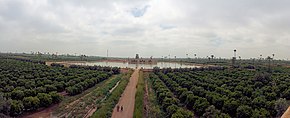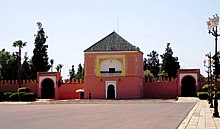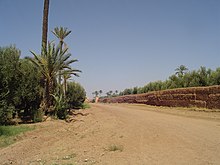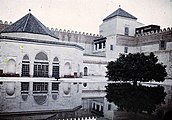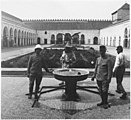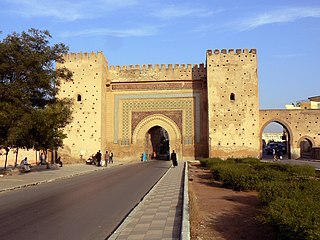
Meknes is one of the four Imperial cities of Morocco, located in northern central Morocco and the sixth largest city by population in the kingdom. Founded in the 11th century by the Almoravids as a military settlement, Meknes became the capital of Morocco under the reign of Sultan Moulay Ismaïl (1672–1727), son of the founder of the Alaouite dynasty. Moulay Ismaïl created a massive imperial palace complex and endowed the city with extensive fortifications and monumental gates. The city recorded a population of 632,079 in the 2014 Moroccan census. It is the seat of Meknès Prefecture and an important economic pole in the region of Fès-Meknès.

A riad or riyad is a type of traditional Moroccan and Andalusi interior garden or courtyard associated with house and palace architecture. Its origin is generally attributed to Persian gardens that spread during the Islamic period. The term is nowadays often used in Morocco to refer to a hotel or guesthouse-style accommodation with shared common areas and private rooms, often within a restored traditional mansion.

Moroccan architecture reflects Morocco's diverse geography and long history, marked by successive waves of settlers through both migration and military conquest. This architectural heritage includes ancient Roman sites, historic Islamic architecture, local vernacular architecture, 20th-century French colonial architecture, and modern architecture.

El Badi Palace or Badi' Palace is a ruined palace located in Marrakesh, Morocco. It was commissioned by the sultan Ahmad al-Mansur of the Saadian dynasty a few months after his accession in 1578, with construction and embellishment continuing throughout most of his reign. The palace, decorated with materials imported from numerous countries ranging from Italy to Mali, was used for receptions and designed to showcase the Sultan's wealth and power. It was one part of a larger Saadian palace complex occupying the Kasbah district of Marrakesh.

The Saadian Tombs are a historic royal necropolis in Marrakesh, Morocco, located on the south side of the Kasbah Mosque, inside the royal kasbah (citadel) district of the city. They date to the time of the Saadian dynasty and in particular to the reign of Ahmad al-Mansur (1578–1603), though members of Morocco's monarchy continued to be buried here for a time afterwards. The complex is regarded by many art historians as the high point of Moroccan architecture in the Saadian period due to its luxurious decoration and careful interior design. Today the site is a major tourist attraction in Marrakesh.

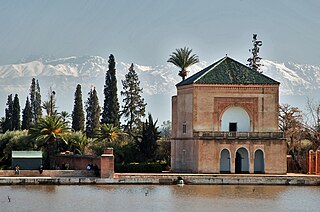
The Menara Gardens are a historic public garden and orchard in Marrakech, Morocco. They were established in the 12th century by the Almohad Caliphate ruler Abd al-Mu'min. Along with the Agdal Gardens and the historic walled city of Marrakesh, the gardens have been listed as UNESCO World Heritage Site since 1985. The gardens are laid out around a central water basin and reservoir, next to which is a pleasure pavilion dating in its current form from the 19th century. The reservoir and its pavilion, often framed in pictures against the background of the High Atlas Mountains to the south, are considered one of the iconic views and symbols of Marrakesh.

Moorish architecture is a style within Islamic architecture which developed in the western Islamic world, including al-Andalus and what is now Morocco, Algeria, and Tunisia. Scholarly references on Islamic architecture often refer to this architectural tradition by a more geographic designation, such as architecture of the Islamic West or architecture of the Western Islamic lands. The use of the term "Moorish" comes from the historical Western European designation of the Muslim inhabitants of these regions as "Moors". Some references on Islamic art and architecture consider this term to be outdated or contested.

Bab Agnaou is one of the best-known gates of Marrakesh, Morocco. Its construction is attributed to the Almohad caliph Abu Yusuf Ya'qub al-Mansur and was completed around 1188 or 1190.
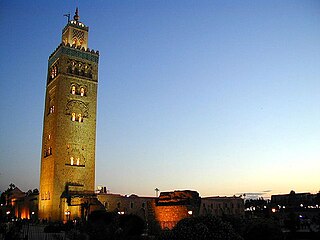
This article describes notable landmarks and architecture in the city of Marrakesh, Morocco.
The Imperial Cities of Morocco are the four historical capital cities of Morocco: Fez, Marrakesh, Meknes and Rabat.

Almohad architecture corresponds to a period from the 12th to early 13th centuries when the Almohads ruled over the western Maghreb and al-Andalus. It was an important phase in the consolidation of a regional Moorish architecture shared across these territories, continuing some of the trends of the preceding Almoravid period and of Almoravid architecture.

The Kasbah Mosque is a historic mosque in Marrakesh, Morocco. It was originally built by the Almohad caliph Yaqub al-Mansour in 1185-1190 CE. It is located in the Kasbah district, the city's former citadel, near the site of its historic royal palaces. Along with the Kutubiyya Mosque, it is one of the most important historic mosques in Marrakesh.

The Royal Palace or Dar al-Makhzen is the palace of the King of Morocco in the city of Fez, Morocco. Its original foundation dates back to the foundation of Fes el-Jdid, the royal citadel of the Marinid dynasty, in 1276 CE. Most of the palace today dates from the 'Alawi era. The vast grounds are home to multiple private structures, patios, and gardens, but historically also included administrative offices and government tribunals. Today, the most publicly visible parts of the palace are its main entrances at the Old Mechouar and the highly ornate 20th-century gates at Place des Alaouites, near the Mellah.

The architecture of Fez, Morocco, reflects the wider trends of Moroccan architecture dating from the city's foundation in the late 8th century and up to modern times. The old city (medina) of Fes, consisting of Fes el-Bali and Fes el-Jdid, is notable for being an exceptionally well-preserved medieval North African city and is classified as a UNESCO World Heritage Site. A large number of historic monuments from different periods still exist in it today, including mosques, madrasas, synagogues, hammams (bathhouses), souqs (markets), funduqs (caravanserais), defensive walls, city gates, historic houses, and palaces.

The Kasbah of Marrakesh is a large walled district in the southern part of the medina of Marrakesh, Morocco, which historically served as the citadel (kasbah) and royal palace complex of the city. A large part of the district is still occupied by the official royal palace, the Dar al-Makhzen, which serves as the residence of the King of Morocco when he visits the city. The rest of the district consists of various neighbourhoods and monuments. It was founded by the Almohads in the late 12th century, with most of the construction carried out by Caliph Ya'qub al-Mansur. Two of its most important surviving structures today, the Kasbah Mosque and the main gate of Bab Agnaou, date from al-Mansur's reign.

The Walls of Marrakesh are a set of defensive ramparts which enclose the historic medina districts of Marrakesh, Morocco. They were first laid out in the early 12th century by the Almoravid dynasty which founded the city in 1070 CE as their new capital. The walls have since been expanded several times by the addition of the Kasbah to the south at the end of the 12th century and by a later extension to encompass the northern neighbourhood around the Zawiya of Sidi Bel Abbes.

The Kasbah of Moulay Ismail is a vast palace complex and royal kasbah (citadel) built by the Moroccan sultan Moulay Isma'il ibn Sharif in Meknes, Morocco. It is also known, among other names, as the Imperial City or Palaceof Moulay Ismail, or the Kasbah of Meknes. It was built by Moulay Isma'il over the many decades of his reign between 1672 and 1727, when he made Meknes the capital of Morocco, and received occasional additions under later sultans.

The Mausoleum of Moulay Isma'il is a historic Islamic funerary complex in Meknes, Morocco. It contains the tomb of Sultan Moulay Isma'il, who ruled Morocco from 1672 until his death in 1727, and is located inside his former Kasbah (citadel). It is a major historic and religious site in the city.

The Buhaira Gardens, also known as the Buhaira Palace or the Buḥayra, is a former Almohad garden and palace in Seville, Spain. It was created in the 12th century. After the Reconquista it was also known in Spanish as the Huerta del Rey or Huerta Dabenahofar in its later history. It is now a public park and historic site.
